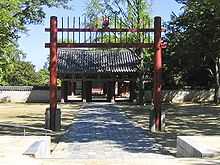Hongsalmun
| Hongsalmun | |
 The hongsalmun at the shrine of the clan Yi of Jeonju | |
| Korean name | |
|---|---|
| Hangul | 홍살문 |
| Hanja | 紅箭門 |
| Revised Romanization | Hongsalmun |
| McCune–Reischauer | Hongsalmun |
Hongsalmun is an architecture built as a gate for entering a sacred place in Korea.[1][2] It is arranged by 2 round poles set vertically and 2 transverse bars.[1] It has no roof and door-gate and placed on the middle top gate there is a symbol of the trisula and the taegeuk image.[1] Hongsalmun is usually erected to indicate Korean Confucian sites, such as shrines, tombs, and academies such as hyanggyo and seowon.[1]
It literally means ‘gate with red arrows’, referring to the set of pointed spikes on its top.
See also
- Iljumun, religious portal